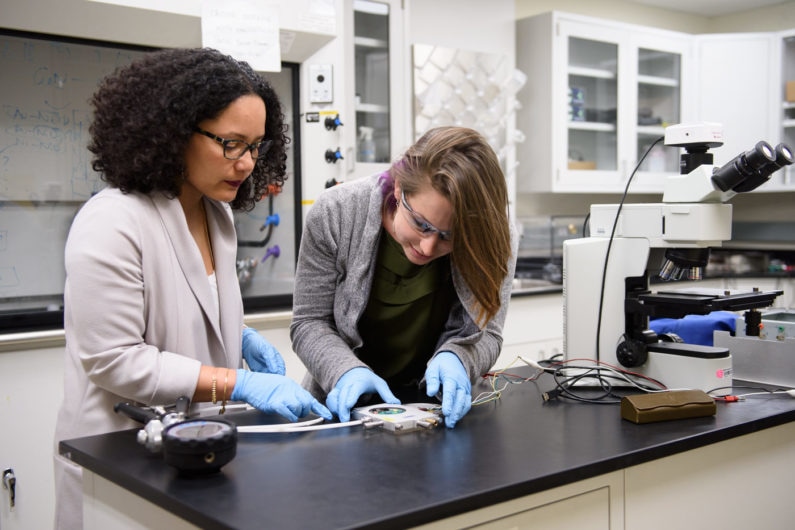Mar 29 2017
 Professor Debbie Senesky, left, works with graduate student Caitlin Chapin on electronics that can resist extreme environments. (Image credit: L.A. Cicero)
Professor Debbie Senesky, left, works with graduate student Caitlin Chapin on electronics that can resist extreme environments. (Image credit: L.A. Cicero)
Venus has a very hot surface hidden behind its thick swirling clouds. The planet is pelted with sulfuric acid rains, and has a temperature of 480 °C, which would burn any of the electronics used currently on Earth. This creates a huge challenge for researchers hoping to explore this extreme environment.
A research team at the Stanford Extreme Environment Microsystems Laboratory (XLab) is eager to conquer these conditions. By designing corrosion-, heat-, and radiation-resistant electronics, they hope to conduct exploration studies in challenging places in the universe – including Earth. This all begins with minute, nano-scale slices of material.
I think it’s important to understand and gain new insight through probing these unique environments.
Debbie Senesky, Assistant Professor, XLab
By exploring Venus, Senesky hopes that man’s understanding of Earth will improve. While it is difficult to imagine that hot and corrosive Venus was ever similar to Earth, scientists believe that it used to be a lot cooler.
It is thought that, billions of years ago, a runaway greenhouse effect might have made the planet to absorb much more heat than it could reflect, forming the scorching conditions present today. Analyzing how Venus became that hot would help scientists here, to understand Earth’s atmosphere.
“If we can understand the history of Venus, maybe we can understand and positively impact the future evolution of our own habitat,” said Senesky.
Additionally, devices that can endure the harshness of space travel could also monitor equally difficult conditions here on Earth, such as in cars.
Scorching heat
One obstacle to exploring extreme environments is the heat. Silicon-based semiconductors, which power laptops and smartphones, stop functioning at roughly 300 °C. When the heat increases, the metal parts start to melt into the neighboring semiconductor and do not transmit electricity as efficiently.
Ateeq Suria, graduate student in mechanical engineering, is one of the people at the XLab working on how to conquer this temperature hurdle. To realize this, he wore his overall lab apparel that prevents contamination - and utilized ultra-clean work spaces to develop an atoms-thick, heat-resistant layer that can coat devices and permit them to function at up to 600 °C in air.
The diameter of human hair is about 70 micrometers. These coatings are about a hundredth of that width.
Ateeq Suria, Graduate Student, XLab
Suria and others at the XLab are studying to enhance these nano-devices, analyzing materials at maximum temperatures of 900 °C. For space electronics, it is a crucial step in comprehending how they endure for long periods of time. While a device may not have to be exposed to that sort of extreme temperature in space, the test conditions quickly aged the materials, revealing how long they could persist.
The XLab team analyzes nano-devices and materials they develop either in-house in high-temperature probe stations or in a Venus simulator at the NASA Glenn Research Center in Cleveland, Ohio. That simulator imitates the chemistry, pressure, and temperature of Venus. To copy the effects of space radiation, they also analyze materials at NASA Ames Research Center and Los Alamos National Laboratory.
Radiation damage
Besides just surviving on Venus, reaching there is also important. Objects in space are pelted by a spell of proton and gamma radiation that knock atoms around and destroy materials. Primary work at the XLab shows that sensors they have created could endure up to 50 years of radiation shower while in Earth’s orbit.
Senesky said that if their fabrication technique for nano-scale materials proves operative it could get added into technologies being sent into space.
I’m super excited about the possibility of NASA adopting our technology in the design of their probes and landers.
Debbie Senesky, Assistant Professor, XLab
Hot electronics at home
Although space is a thrilling frontier, Suria states that it was the interest to understand car engines that primarily fueled this research. Within an engine, temperatures can go up to 1000 °C, while the outer surface of a piston can reach 600 °C. Existing technology to monitor and improve engine performance cannot handle this heat, causing error because measuring devices have to be positioned far away from the pistons.
Electronics engineered to endure the intense conditions of space could be positioned next to the engine’s pistons to directly monitor performance and enhance efficiency.
“You just put the sensor right in the engine and get much better information out,” said Suria.
Other scorching, high pressure earth-bound environments that would profit from these strong electronics include aircraft engines, geothermal vents, oil and gas wellbores, hypersonic structures, and gas turbines.